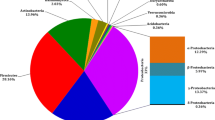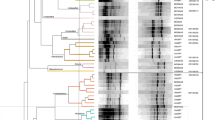Abstract
Tylenchulus semipenetrans is a major plant-parasitic nematode pest of citrus which readily infests sour orange rootstock Citrus aurantium. In order to examine the bacterial diversity and prevalence in the nematode infested citrus rhizosphere, 282 bacterial strains were isolated from roots of mature citrus trees, from egg masses of T. semipenetrans, and from nematophagous fungi in the orange producing area Cap bon in Tunisia. The rhizosphere of citrus had a high diversity of bacterial strains among the 20 agricultural parcels. According to morphological and biochemical characteristics, sixty bacteria strains were selected to explore the diversity of biological activity. None of the bacterial strains considered in this study have phytopathogenic activity. Each strain was identified and tested as a potential natural antagonist against fungi and against citrus nematode (egg hatching and juvenile mortality). Bacillus cereus, B. mycoides, B. pumilus and B. thuringiensis were the four most abundant species regardless the sampling location. Canonical discriminant analysis grouped the bacteria into five groups of biological activities: Group A, similar to water control, had not specific effect. Group B showed strong effect, and group C caused moderate growth inhibition of the nematophagous fungi Monacrosporium cianopagum CBM. Group C had stronger growth inhibition of the fungus Arthrobotrys conoides RGA than groups B and D. Groups D and E showed a strong activity on nematode egg hatch inhibition.



Similar content being viewed by others
References
Araú́jo, W. L., Marcon, J., Maccheroni, W., Jr., van Elsas, J. D., van Vuurde, J. W. L., & Azevedo, J. L. (2002). Diversity of endophytic bacterial populations and their interaction with Xylella fastidiosa in citrus plants. Applied and Environmental Microbiology, 68(10), 4906–4914.
B’Chir, M. M., & Belkadhi, M. S. (1986). Nouvelles données sur les modifications histologiques induites par le Complexe Fusarium solani - Tylenchulus semipenetrans au niveau des racines de portes greffes de citrus. Mededelingen Faculteit Landbouwwetenschappen Rijksuniversiteit Gent, 51(3b), 1295–1310.
B'Chir, M. M., & Namouchi, N. (1988). Effect of Bacillus pumilus on Monacrosporium salinum, a nematode trapping fungus Revue de nématologie, 11(2), 263–266.
Borriss, R. (2011). Use of plant-associated Bacillus strains as biofertilizers and biocontrol agents. In D. K. Maheshwari (Ed.), Bacteria in agrobiology: Plant growth responses (pp. 41–76). Heidelberg: Springer.
Burkett-Cadena, M., Kokalis-Burelle, N., Lawrence, K. S., van Santen, E., & Kloepper, J. W. (2008). Suppressiveness of root-knot nematodes mediated by rhizobacteria. Biological Control, 47, 55–59.
Chowdhury, S. P., Hartmann, A., Gao, X. W., & Borriss, R. (2015). Biocontrol mechanism by root-associated Bacillus amyloliquefaciens FZB42 – A review. Frontiers in Microbiology, 6, 780.
Dagnelie, P. (1975). Analyse statistique à plusieurs variables. Gembloux, Presses agronomiques, 362 p.
Duncan, L. W. (1968). The spatial distribution of citrus feeder roots and the citrus nematode, Tylenchulus semipenetrans. Revue de nématologie, 9(3), 233–240.
El-Borai, F. E., Duncan, L. W., & Graham, J. H. (2002a). Infection of citrus roots by Tylenchulus semipenetrans reduces root infection by Phytophthora nicotianae. Journal of Nematology, 34(4), 384–389.
El-Borai, K. F., Duncan, L. W., & Graham, J. H. (2002b). Eggs of Tylenchulus semipenetrans inhibit growth of Phytophthora nicotianae and Fusarium solani in vitro. Journal of Nematology, 34, 267–272.
El-Borai, F. E., Duncan, L. W., Graham, J. H., & Dickstein, E. (2003). Tylenchulus semipenetrans alters the microbial community in the citrus rhizosphere. Journal of Nematology, 35(2), 167–177.
Iatsenko, I., Nikolov, A., & Sommer, R. J. (2014). Identification of distinct Bacillus thuringiensis 4A4 Nematicidal factors using the model nematodes Pristionchus pacificus and Caenorhabditis elegans. Toxins, 6, 2050–2063.
Jongsik, C., & Kyung, S. B. (2000). Phylogenetic analysis of Bacillus subtilis and related taxa based on partial gyrA gene sequences. Antonie van Leeuwenhoek, Kluwer Academic Publishers, 78, 123–127.
Kalai-Grami, L., Ben Slimane, I., Mnari-Hattab, M., Rezgui, S., Aouani, M. A., Hajlaoui, M. R., & Limam, F. (2014). Protective effect of Bacillus amyloliquefaciens against infections of Citrus aurantium seedlings by Phoma tracheiphila. World Journal Microbiology Biotechnology, 30, 529–538.
Kallel, S., & Labiadh, M. (2010). Behaviour of the community of nematode trapping fungi isolated from the rhizosphere of citrus naturally infested with Tylenchulus semipenetrans. Nematologia Mediterranea, 38(2), 135–144.
Ki, J. S., Zhang, W., & Qian, P. Y. (2009). Discovery of marine Bacillus species by 16S rRNA and rpoB comparisons and their usefulness for species identification. Journal of Microbiological Methods, 77, 48–57.
Klement, Z., Farkas, G. L., & Lovrekovich, L. (1964). Hypersensitive reaction induced by phytopathogenic bacteria in the tobacco leaf. Phytopathology, 54, 474–477.
Montasser, S. A., Abd El-Wahab, A. E., Abd-Elgawad, M. M. M., Abd-El-Khair, H., Faika, F. H. K., & Hammam, M. M. A. (2012). Effects of some fungi and bacteria as bio-control agents against citrus nematode Tylenchulus Semipenetrans cobb. Journal of Applied Sciences Research, 8(11), 5436–5444.
Nihorimbere, V., Ongena, M., Smargiassi, M., & Thonart, P. (2011). Beneficial effect of the rhizosphere microbial community or plant growth and health. Biotechnology, Agronomy, Society and Environment, 15(2), 327–337.
Orion, D., & Kritzman, G. (1991). Antimicrobial activity of Meloidogyne javanica gelatinous matrix. Revue de Nématologie, 14(4), 481–483.
Orion, D., Kritzman, G., Meyer, S. L. F., Erbe, E. F., & Chitwood, D. J. (2001). A role of the gelatinous matrix in the resistance of root-knot nematode (Meloidogyne spp.) eggs to microorganisms. Journal of Nematology, 33(4), 203–207.
Pandey, A., Palni, L. M. S., & Bisht, D. (2001). Dominant fungi in the rhizosphere of established tea bushes and their interaction with the dominant bacteria under in situ conditions. Microbiological Research, 156, 377–382.
Tian, B., Yang, J., & Zhang, K. Q. (2007). Bacteria used in the biological control of plant-parasitic nematodes: Populations, mechanisms of action, and future prospects. FEMS Microbiology Ecology, 61(2), 197–213.
Trivedi, P., Spann, T., & Wang, N. (2011). Isolation and characterization of beneficial bacteria associated with citrus roots in Florida. Microbial Ecology, 62, 324–336.
Vidal-Quist, J. C., Castañera, P., & González-Cabrera, J. (2009). Diversity of Bacillus thuringiensis strains isolated from citrus orchards in Spain and evaluation of their insecticidal activity against Ceratitis capitata. Journal of Microbiology and Biotechnology, 19(8), 749–759.
Weller, D. M. (1988). Biological control of soilborns plant pathogens in the rhizosphere of bacteria. Annual Review of Phytopathology, 26, 379–407.
Yu, G. Y., Sinclair, J. B., Hartman, G. L., & Bertagnolli, B. L. (2002). Production of iturin a by Bacillus amylolequefaciens suppressing Rhizoctonia solani. Soil Biology & Biochemistry, 34, 955–963.
Acknowledgments
Authors are grateful to Mrs. C. Tricot (IRMW) for research assistance.
Author information
Authors and Affiliations
Corresponding author
Ethics declarations
Conflict of interest
The authors declare that they have no conflict of interest.
Ethical approval
This article does not contain any studies with human participants or animals performed by any of the authors.
Informed consent
Not applicable.
Rights and permissions
About this article
Cite this article
Labiadh, M., Aidi, R., M’hamdi, B. et al. Occurrence and functional diversity of bacteria in rhizosphere of citrus trees infested by Tylenchulus semipenetrans in a citrus-growing area of Tunisia. Eur J Plant Pathol 155, 475–488 (2019). https://doi.org/10.1007/s10658-019-01781-4
Accepted:
Published:
Issue Date:
DOI: https://doi.org/10.1007/s10658-019-01781-4




